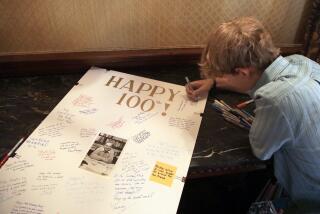Science / Medicine : It Was Expert’s Prime Time When His Number Came Up
- Share via
Luther Welsh remembers vividly the moment his number came up.
On Feb. 1, Welsh received a telephone call at his El Toro home from computer scientist Walter Colquitt in Houston. Colquitt told him that, after a 1 1/2-year search with the help of a huge computer in Houston, they had discovered the 31st known Mersenne prime number.
“When Walter called me . . . I yelled so loudly he could have heard me back in Houston without the telephone,” Welsh recalled in an interview last week.
Within the world of mathematics, Welsh and Colquitt are in select company. “Hey, I’m on the same small list (of discoverers of Mersenne primes) as Euclid,” said Welsh, referring to the ancient Greek scholar.
Don’t expect to read the entire number here, however.
“It has 33,265 digits,” Welsh said. “It takes up about six computer pages.”
A prime number is one that is divisible only by itself and 1, such as 2, 3, 5, 7, 11 and so on.
Mersenne primes are still rarer forms of prime numbers. Named after Marin Mersenne, a 17th-Century French monk and mathematician, Mersenne primes take the form of the number 2 raised to a prime power minus 1. The lowest Mersenne prime numbers are 3 (2 to the second power minus 1), 7 (2 to the third power minus 1) and 31 (2 to the fifth power minus 1).
Mersenne, a contemporary of Galileo and philosopher Rene Descartes, first proposed the formula in 1644. Mathematicians ever since have used it as an aid in finding new prime numbers.
Before the Colquitt-Welsh discovery, the world knew of only 30 Mersenne prime numbers. The last one was found in September, 1985. But on Jan. 29, the pair proved the existence of the 31st such rare prime number.
The new Mersenne prime is the third largest of the 31. Formally presented, the new Mersenne prime is: 2 raised to the 110,503 power, minus 1.
Harry Nelson, a distinguished computer scientist at UC Berkeley’s Lawrence Livermore National Laboratory in Livermore, is among experts who have verified the new Mersenne prime. Nelson, who discovered a Mersenne prime number himself about 10 years ago, said he checked the Colquitt-Welsh prime and found it to be accurate.
“At least three of us who are active in this field have checked this, and all of us used the same (test) technique that was developed at UC Berkeley in the 1930s,” Nelson said.
So large a number as that discovered by Colquitt and Welsh has no immediate pragmatic value, Nelson conceded. “It’s now just a discovery of pure science,” he said. But as recently as a decade ago, he said, numbers with 100 digits had no practical value. “Now those numbers are used in the coding of secret information.”
Colquitt, 46, is the senior systems engineer for the array of computers operated by the Houston Area Research Center. The center is operated jointly by the University of Texas, Texas A&M; University, Rice University and the University of Houston. Colquitt said the arrival in 1986 of a huge new NEC SX2 computer at the center--nicknamed “Godzilla”--made it possible to speed the search for a new Mersenne prime.
“Luther and I got together just by accident,” said Colquitt. He said that he and a Japanese computer firm representative were chatting in September, 1986, shortly after the new super-computer arrived at the Houston center. “I told the Japanese man that I was interested in finding a new Mersenne prime, and he told me I should get in touch with Luther Welsh in California, because he was also working on the same thing.”
Soon after, Colquitt telephoned Welsh, and they began swapping information. The 37-year-old Welsh eventually visited the Houston research center in 1987.
A computer programmer who said he is currently between jobs, Welsh has had a lifelong interest in numbers. For the last five years, he has worked in his spare time on a personal computer at his El Toro home, designing programs to narrow the search for a Mersenne prime.
Welsh said he started with a field of about 34,000 numbers that might be candidates for Mersenne primes. With his computer program, he was able to narrow the field to about 17,000. It was then, in September, 1986, that he and Colquitt teamed, using the capabilities of the Houston computer to help them search and test for the number.
Welsh designed the program that enabled the computer to gradually narrow the field of possible primes.
While they may have gained a measure of recognition in mathematical circles, both men acknowledge that little fame and virtually no fortune stems from their discovery.
“I was a hit with a school kid who’s a neighbor because his math class had discussed our find,” Welsh said. Otherwise, he said, the world has hardly beaten a path to his El Toro doorway.
As for riches from the discovery, Colquitt said a Houston bar gave him some regal treatment for the new discovery: “I got a free pitcher of beer.”





